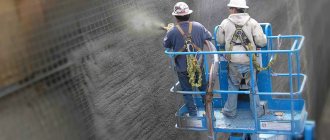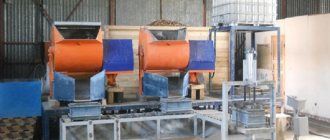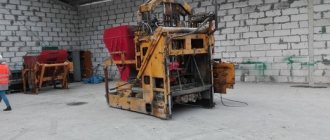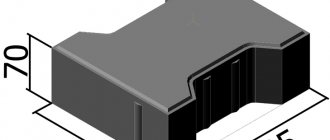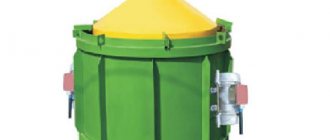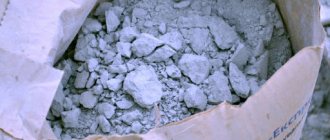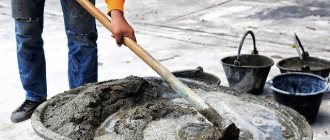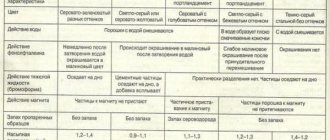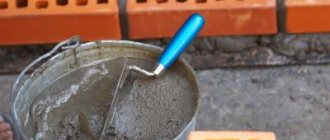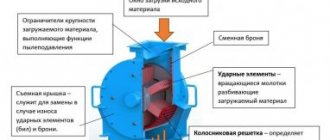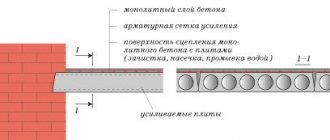Cement is one of the most popular materials in the construction market. It is a binding powder for the preparation of mortar and various products. In its production, clinker, gypsum, limestone and various mineral additives are used. The technical characteristics of cement powder depend on the characteristics of the composition and percentage of certain components.
Today, one of the most popular of all building materials is Portland cement. It has unique characteristics and has a wide range of applications. This type of mixture is used to prepare special solutions for repair and restoration work, for the production of mixtures for brickwork, and for the production of reinforced concrete products. Portland cement is used in all areas of construction: from civil to aviation.
Advantages of bagged cement
In construction stores, cement is sold in bulk and packaged form. Some may think that there is no difference between the 2 types of goods, but this is not so. Cement is a powdery bulk material, the transportation of which is accompanied by a lot of difficulties.
To deliver it you will need transport that meets special requirements. This means that it will not be possible to bring bulk cement to the construction site in the trunk of a car. The buyer will have to rent a special car, which will result in additional expenses.
Cement packaged in bags is easier and faster to transport, so there will be no problems with loading and unloading it. Several people will transport packages of construction material to the required location in a matter of minutes, while bulk cement will have to be unloaded using special equipment, the search for which will require additional effort, time and financial resources.
Those purchasing bulk goods will need to find a place to store them. In warehouses, cement is provided with conditions in which its physical and chemical properties can be preserved. Building material must be protected from humidity and temperature changes, which is not always possible to do outside the warehouse.
Purchasing a packaged product solves this problem, since the necessary storage conditions are provided inside the mixture bag. In addition, the packages take up less space and can be easily placed in a small room by stacking them on top of each other.
It is easier to control the consumption of cement in packaging visually: if a 50 kg bag is half empty, it means that about 25 kg of its contents have been consumed. It will not be possible to determine the mass of a bulk product without weighing.
By purchasing packaged goods, the buyer can be confident in its quality. The packaging contains information about the brand, weight and manufacturer. Factory bags consist of several layers; they protect building materials from moisture and other factors that can reduce its quality.
An equally important advantage of buying a product packaged in bags is savings. The larger the package, the cheaper each kilogram of its contents will cost.
Organizational plan
Registration
To carry out entrepreneurial activities to implement this business project, an aspiring entrepreneur must go through the mandatory procedure for state business registration. This project assumes the possibility of carrying out activities in the form of an individual entrepreneur without forming a legal entity or a limited liability company.
The first option is simpler in terms of preparing and submitting accounting and financial statements to the tax authority, while registration in the form of a legal entity provides the opportunity for direct cooperation with other legal entities, which will have a positive impact on the prospects of the business.
You must submit a package of pre-collected and completed permitting documentation to the registration authority; in addition, you must register with the local tax authority. It is recommended to work according to a simplified taxation system, which implies the mandatory payment of regular quarterly tax contributions in the form of 15% of net profit or 6% of income at the choice of a beginning entrepreneur.
Room
The correct selection of premises for a plant or mini-plant for cement packaging plays an important role in the process of implementing a business project. The required area for the equipment used and storage of consumables, as well as finished products, depends on the choice of the scale of the enterprise’s activities. First of all, you need to be puzzled by the correct selection of a location for the location of the enterprise.
It is recommended to choose an area remote from the residential and central areas of the city in the industrial zone of the settlement. At the same time, it is necessary to take into account the convenience of transport accessibility. Also, an important advantage will be the absence of competing companies at a close distance from the location of the enterprise.
It is worth considering not only the arrangement of the workshop and storage facilities, but also the design of the surrounding area for convenient loading and unloading of vehicles.
Equipment
To set up the plant, you will need to purchase and put into operation the following equipment:
- crushing machines for limestone processing;
- special mills for grinding clay;
- ball tube mills used to obtain a homogeneous mass;
- kilns;
- special refrigeration units for clinker cooling;
- other consumables, raw materials and tools.
Staff
A budding entrepreneur needs to worry about employing his staff. It is necessary to hire a manager, process engineer, specialist workers, technical staff and security. For accounting services and legal support at the initial stage, it is recommended to contact third-party financial and legal agencies. In the future, if necessary, it will be necessary to create a fully functional financial and legal department. The same rule applies to marketing and promotional activities to attract initial customers.
Areas of application
The construction of houses in Moscow and the Moscow region is carried out on a large scale, cement is used in many works.
Developers purchase it in 50 kg bags and use it for:
- creating foundations, floor slabs, reinforced concrete structures, window slabs;
- construction of brick walls;
- cement-sand floor screed;
- preparation of concrete, cement plaster.
Most often, cement of the M400 and M500 brands is sold in packaged form. The numerical value next to the letter M indicates the compressive strength of the hardened material. A product marked M400 can withstand a load of 400 kg per 1 cm³, M500 - 500 kg per the same area.
Supervision activities at the plant
To open a plant, it is necessary to collect permits from various authorities, Rospotrebnadzor, the fire inspectorate and the local branch of the sanitary-epidemiological station. Packaging containers must comply with mandatory state quality standards and established regulatory requirements of current domestic legislation.
The important role of special additives
To improve quality, mineral additives are often added to cement in production. They provide the product with additional properties: rapid hardening, frost resistance, protection from moisture, corrosion, etc. Additives are designated on the packaging with the letter D.
You can find out what additional substances are included in the construction mixture by studying the information on the bag.
For example, if it bears the inscription M400 D0, then no additives were used in the production of the product. The M500 D20 marking indicates that 20% of the contents of the package are additional substances.
The letters following the numerical designation will help you find out what additives were used in the production of cement and what it is intended for:
- PC - Portland cement (a mixture of clay and clinker). Used in almost all cement compositions. May harden in high humidity conditions.
- BC - white cement. Contains low-iron clinker, gypsum, limestone and mineral additives that give it a light shade. Designed for finishing work.
- PL is a plasticized mixture created from Portland cement and sulfite-alcohol concentrates. It is characterized by increased plasticity and frost resistance, used in regions with cold winters.
- B - quick-hardening mixture. It is obtained from clinker, which is characterized by a special mineralogical composition. It is used in urgent work when there is no time to wait for the building material to dry. It is characterized by increased strength.
- ShPC - Portland slag cement. Made from clay, clinker and slag. The composition provides resistance to high temperatures and water.
- GF is a hydrophobic species. Contains hydrophobic additives that give it increased frost resistance, moisture resistance and plasticity.
Purchasing packaged cement is the right decision when major construction work is ahead. The information on the bag will help you choose the required brand of material and select the composition that is most suitable for the case.
Differences in markings of old and new GOSTs
According to the old GOST, the letter M and the number following it denoted compressive strength, that is, the ultimate strength of the product, expressed in kg, after which it begins to collapse. For example, the M500 cement grade means that the material can withstand up to 500 kg of load per 1 cm2. Cement M was produced in a standard range from 100 to 700 kg per cm2.
The new marking indicates the same characteristic in megapascals and can only be indicated by a number - and this will already be a strength class. For example, from the inscription “CEM 42 cement” it follows that the product can withstand a pressure of 42 MPa.
The product packaging contains such an indicator as the speed of hardening:
- CEM I - quick-hardening Portland cement with the amount of additives no more than 5%; it takes no more than 2 days for the concrete to reach the required strength;
- CEM II - normal-hardening cement with additives up to 35% of the total volume of the mixture, which affect the reduction in the rate of hardening;
- CEM III - Portland cement, which contains slag (from 36 to 65%);
- CEM IV - cement with a normal hardening rate, it contains an additive such as ash (Z), and microsilica (MC) is also present;
- CEM V is a binding powder that contains up to 30% slag in the form of granules and up to 30% ash.
The hardening speed is indicated by the letters “B” and “N”:
- “B” - quick-hardening cement;
- "N" - normal hardening.
The marking CEM 42.5N means normal-hardening Portland cement with a strength of M500.
The amount of additives in the cement mixture, according to the old standard, was indicated by the letter “D” and the following number:
- D0 indicates the absence of impurities, this is one of the best brands;
- D5 means that additives are no more than 5% of the total mass;
- D20 - the mixture contains no more than 20% of various impurities.
The new European standard used the Cyrillic script, and the letters TsEM indicate the binding powder - cement. The letter following the fraction sign (“/”) is the designation of the type of mixture:
- “A” indicates the presence of 6 to 20% mineral additives in the powder;
- "B" - from 20 to 35%.
Additives and their letter designations
If there are various impurities in the cement mixture, this should be reflected on the packaging. The Cyrillic letter indicated in the labeling may indicate one or another additive:
- “G” - gliezh, slates;
- "I" - limestone;
- “Z”—fly ash;
- "K" - composite;
- "MK" - silica;
- "Sh" - slag.
In addition to all the above parameters, there are some specific characteristics of one or another component of the cement mixture, which may be inherent in non-standard and specific types of this building material. They are not indicated on the packaging and their presence is specified separately.
Advantages of paper packaging
- Paper is an environmentally friendly material.
- Paper packaging has a low price.
- After using the dry mixture, the bags are easy to dispose of and are recyclable.
- Unlike polyethylene, paper removes condensation from the contents.
The laminated outer layer of the bag reliably protects the cement or mixture from atmospheric moisture.
Note:
Our company produces all types of corrugated cardboard and corrugated boxes. We know almost everything about packaging. We are ready for cooperation. The corrugated packaging catalog can be viewed here.
But we produce and sell all types of corrugated boxes
Paper bags for dry mixtures come in open and valve types.
The valves are completely closed, there is only one hole into which the mixture is poured. Once filled, the valve closes.
Opened ones come with the top unsealed. After packaging, the neck is sewn up, sealed with tape or sealed with a stapler.
ACV with pneumatic self-unloading and loading (Fig. 2).
To load ACV not from a silo, with dust-like material lying freely on the surface of a concrete platform, ACV with pneumatic self-loading is used. For this purpose, to suck up the material, it is necessary to create a vacuum inside the tank, which is realized by the same compressor.
Sleeve 2 of tank 3 is separated from compressor 1 and connected to the suction pipe of the tank. Turn on the compressor and pump air out of the tank, creating a vacuum in it. The intake device 5 is inserted into the depths of the freely lying material and the valve is turned, after which the material, under the influence of the difference in pressure of the outside air and the vacuum inside, is sucked into the tank and fills its volume to the level recorded by the alarm sensor.
Backwash of cement into the compressor is prevented by the presence of a fabric filter in the tank and in the hose. The process of unloading from such ACVs is carried out in the manner described above. Technical characteristics of ACV. Load capacity, kg from 8000 to 22000; Own weight, kg from 3300 to 7850; Geometric volume of the tank, m 3 from 8.87 to 21; Operating volume, m 3 from 7 to 20; Self-loading capacity, t/min from 0.5 to 1; Unloading capacity, t/min from about 5 to 1
ACV with pneumatic unloading (Fig. 1)
The ACV consists of a tractor vehicle and a tank attached to a semi-trailer. The tank is installed on a semi-trailer with a horizontal inclination of 7-9° towards unloading. At the top of the tank there are loading hatches with covers equipped with rubber seals and a screw clamp of the cover to the hatch seat, ensuring the tightness of the internal volume of the tank.
Inside the tank there are side slopes and an air chute, which is a fine-mesh mesh stretched along the axis of the tank, or a perforated steel sheet, with a multilayer porous cotton fabric attached to the mesh or sheet. In the rear part, in the direction of travel of the tank, there is a discharge pipe with a tap and a nozzle for purging. Using a tap, the flow rate of unloaded dust and the creation of excess pressure in the internal volume of the tank are regulated, immediately before unloading.
The tractor unit is equipped with a rotary type compressor, the drive of which is carried out from the engine power take-off unit, through a transmission shaft and a V-belt drive. The compressor is equipped with an air filter and a safety valve. The compressor flow pipe is connected to the tank with a quick-release coupling.
Transportation of cement without packaging.
This type of transportation is used for large volumes of cement delivery to a construction site, which significantly reduces the cost of this part of the construction technology, because There is no cost of the packaging itself and no costs for the packaging process at the manufacturing plant.
For this purpose, special types of transport are used:
on the railway these are hopper cars or tank cars; In road transport, cement tankers and cars with a trailer are used, on which a tank is installed; cement can be unloaded from it only with a compressor, which is an integral part of the cement tanker’s equipment.
The most common way to transport bulk cement, from the manufacturer's plant to the construction site, is to transport it using automobile cement tankers (ACV). They are designed to transport cement over a distance of no more than 150 km, and other dusty materials over a distance of more than 500 km.
Pneumatic unloading of railway tanks (Fig. 3)
Unloading cement from railway tanks using a pneumatic method is similar to unloading road tanks. The railway tank is loaded with cement at the manufacturing plant through hatches in its upper part and moved to the construction site over long distances. After installing the tank at the unloading site, a rotary compressor driven by an electric motor is connected to it.
Compressed air from the compressor, through a distribution device, is supplied to the space of the tank above the layer of material in it and, at the same time, to the space under the air trays installed inside the tank.
The air trays are installed with a slope towards the middle part of the tank and the cement-air mixture formed in the area above the trays begins on both sides to shift towards unloading. Through a hatch in the middle of the tank, cement, separated from the air, enters the collector and from there is unloaded into prepared containers or poured freely.
When pneumatically unloading cement using all the methods described above, an environment of increased dustiness of the working area with harmful cement dust may arise, therefore, personnel must comply with all the requirements of the unloading instructions and strictly adhere to sanitation standards.
How does ACV with pneumatic unloading work?
At the manufacturing plant, before shipment, cement is stored in factory silos with dispensers. The ACV drives up to the loading ramp below them and, through the top hatch, is loaded with a certain volume of material.
After transporting the cement to the construction site, it is unloaded into pockets prepared for receiving bulk material. Unloading is carried out as follows. The compressor 4 installed on the ACV is turned on and the compressed air is supplied through the moisture-oil separator 3 and the air distributor 2 inside the tank to the air chute 5 and to the nozzle 6, through a pipeline equipped with a check valve. Compressed air penetrates through the mesh and porous fabric, mixes with cement and this mixture flows down the aerial chute to the unloading unit, where the cement, carried away by the air flow from the nozzle, through a large diameter hose, is unloaded to a prepared place on the construction site.
